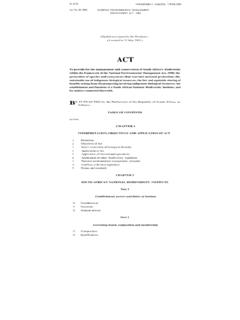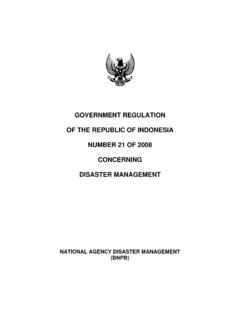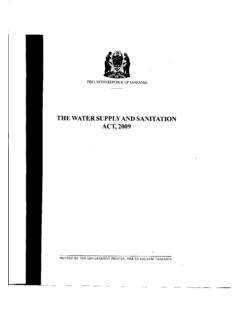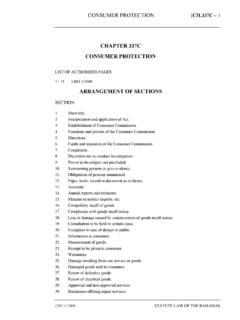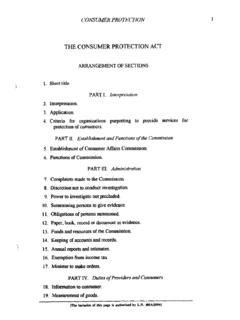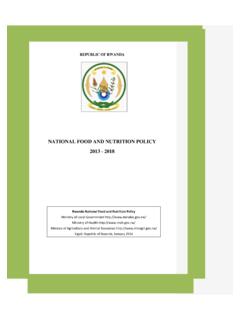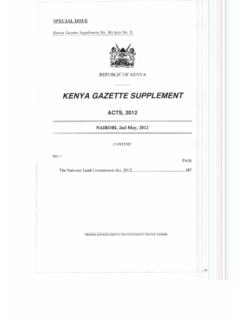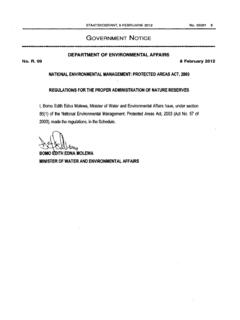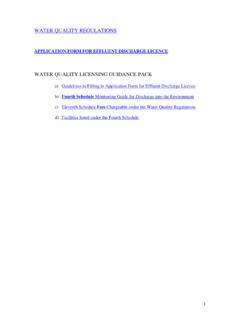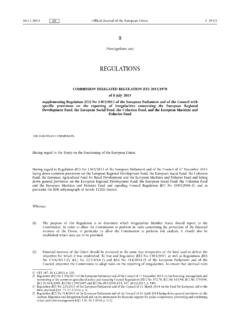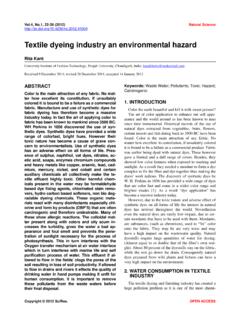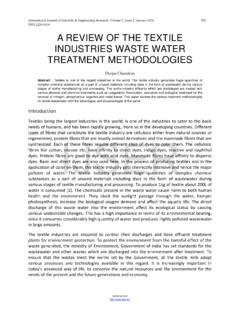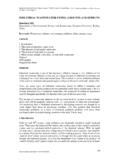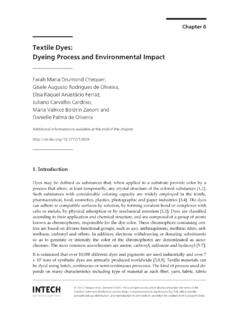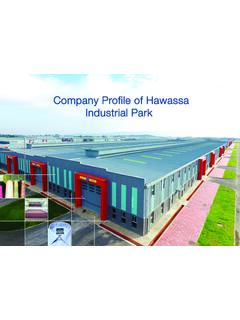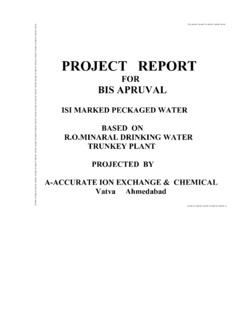Transcription of Effluent Standards - Faolex
1 Effluent Standards Original 4 articles promulgated by Department of Health Order Wei-Shu-Huan-Tzu No. 654798 on May 5, 1987. Revisions promulgated by EPA Order (80) Huan-Shu-Fa-Tzu No. 00359 on January 16, 1991. Revisions promulgated by EPA Order (80) Huan-Shu-Fa-Tzu No. 46873 on November 29, 1991. Revisions promulgated by EPA Order (86) Huan-Shu-Shui-Tzu No. 09953 on March 19, 1997. Revisions promulgated by EPA Order (86) Huan-Shu-Shui-Tzu No. 78804 on December 24, 1997. Revisions to Article 6 promulgated by EPA Order (88) Huan-Shu-Shui-Tzu No. 0060545 on September 22, 1999. Revisions to original eight articles promulgated by EPA Order (89) Huan-Shu-Shui-Tzu No. 0004191 on February 9, 2000. Revisions to Articles 2 and 6 promulgated by EPA Order (90) Huan-Shu-Shui-Tzu No.
2 0004055 on February 7, 2001. Revisions to Article 2 promulgated by EPA Order (90) Huan-Shu-Shui-Tzu No. 0069097 on November 21, 2001. Revisions to Article 2 promulgated by EPA Order Huan-Shu-Shui-Tzu No. 09200847 on November 26, 2003. Revisions to original eight articles promulgated by EPA Order Huan-Shu-Shui-Tzu No. 0960065740 on September 3, 2007. Revisions to Articles 2 and 6 promulgated by EPA Order Huan-Shu-Shui-Tzu No. 0980065341 on July 28, 2009. Nine articles promulgated by EPA Order Huan-Shu-Shui-Tze No. 0990112348F on December 15, 2010. Revisions to Articles 2 promulgated by EPA Order Huan-Shu-Shui-Tzu No. 10000103860 on December 1, 2011. Revisions to Articles 2,5 and 6 promulgated by EPA Order Huan-Shu-Shui-Tzu No. 1010090770 on October 12, 2012.
3 Revisions to Articles 2 promulgated by EPA Order Huan-Shu-Shui-Tzu No. 1030005842 on January 22, 2014. Article 1 These Standards are determined pursuant to Article 7, Paragraph 2 of the Water Pollution Control Act (herein referred to as this Act). Article 2 Water quality items and limits for Effluent Standards for enterprises, sewage systems and building sewage treatment facilities are as follows in the table: Applicable scope Effluent characteristics Effluent limits Notes Generally applicable to wastewater from industries, sewage systems and sewage treatment facilities attached to buildings Water temperature 1. For effluents discharged into surface water bodies other than the ocean: A. Below 38 C (from May to September) B.
4 Below 35 C (from October to April) effluents discharged directly into marine waters, the Applicable scope Effluent characteristics Effluent limits Notes temperature at the discharge point shall not exceed 42 C; and the temperature difference should not exceed 4 C for surface water at 500 meters from the discharge point. pH Fluorides (not including complex ions) 15 Nitrate nitrogen 50 Not applicable to newly established public sewers used to discharge wastewater or sewage within water source quality and volume protection areas. (Newly established public sewers means sewage systems for which planning had not been completed by November 23, 2001 or planning had been completed but project bid requests had not yet been made.) Ammonia nitrogen 10 1.
5 Controls on ammonia nitrogen and orthophosphates shall apply to the discharge of wastewater or sewage in water source quality and volume protection areas. However, the competent authority in consultation with the industry competent authority shall draft a control timetable and Effluent Standards for Orthophosphates (calculated as trivalent phosphate radicals) Applicable scope Effluent characteristics Effluent limits Notes ammonia nitrogen and orthophosphate generated by the livestock industry. on the discharge of orthophosphates are not applicable to the discharge of wastewater or sewage into water source quality and volume protection areas by newly established public sewers. (Newly established public sewers means sewage systems for which planning had not been completed by November 23, 2001 or planning had been completed but project bid requests had not yet been made.)
6 Phenols Anionic surfactants 10 Cyanide Oil and grease (n-hexane extract) 10 Soluble iron 10 Soluble manganese 10 Cadmium Lead Total chromium Hexavalent chromium Methyl mercury Total mercury Copper Zinc Silver Applicable scope Effluent characteristics Effluent limits Notes Nickel Selenium Arsenic Boron Sulfide Formaldehyde PCBs Total organophosphorous compounds (such as Parathion, Diazinon, Tamaron, Azodrin,EPN, etc.) Total aminomethyl-carbamate (such as Mipcin, Carbofuran, Lannate, Unden,BPMC, etc.) Herbicides (such as Butachlor, Paraquat,2,4-D (sodium), Lasso,CNP-MCPA, Glyphosate, etc.) Endosulfan Endrin Lindane Heptachlor and its derivatives DDT and its derivatives Aldrin, Dieldrin Pentachlorophenol and its salts Toxaphene Pentachloronitro-benzene Folpet (phaltan) Captafol Captan Applicable scope Effluent characteristics Effluent limits Notes Dioxin 10 1.
7 Applicable to Existing enterprises, including pulp industry and those with the waste incinerators using wet or semi-dry scrubbers for air pollution control and producing wastewater discharged into the wastewater treatment plant. 2. Existing enterprises means those enterprises that had been completed, were in construction, or for which project bid request procedures had been completed as of October 12, 2012. 5 1. Applicable to newly-established enterprises, including pulp industry and those with the waste incinerators using wet or semi-dry scrubbers for air pollution control and producing wastewater discharged into the wastewater treatment plant. 2. "Newly-established enterprises" means those enterprises for which planning had not been completed as of October 12, 2012, or for which planning had been completed, but project bid request procedures had not yet been completed as of that time.
8 Printing, dyeing, and finishing industry Dyeing and finishing of printed and woven textiles Biological oxygen demand (BOD) 30 Chemical oxygen demand (COD) 160 Suspended solids 30 True color 550 Applicable scope Effluent characteristics Effluent limits Notes Cone dyeing, hank dyeing and knit and unwoven textile dyeing and finishing Biological oxygen demand (BOD) 30 Chemical oxygen demand (COD) 140 Suspended solids 30 True color 550 Finishing, paper printing, wool brushing, wool cutting, wool buffing, and others not belonging to the above two categories Biological oxygen demand (BOD) 30 Chemical oxygen demand (COD) 100 Suspended solids 30 True color 550 Leather tanning industry Finished leather made from raw hide Biological oxygen demand (BOD) 30 Chemical oxygen demand (COD) 160 Suspended solids 30 True color 550 Finished leather made from wet blue Biological oxygen demand (BOD) 30 Chemical oxygen demand (COD) 200 Suspended solids 30 True color 550 Others not belonging to the categories finished leather made from raw hide and finished leather made from wet blue Biological oxygen demand (BOD) 30 Chemical oxygen demand (COD) 100 Suspended solids 30 True color 550 Pulp industry Chemical oxygen demand (COD) 150 Suspended solids 50 True color 550 Fermentation industries (brewing industry; MSG production industry.)
9 Wine or liquor, alcohol and vinegar production industries; soy sauce Biological oxygen demand (BOD) 50 Chemical oxygen demand (COD) 150 Suspended solids 50 Applicable scope Effluent characteristics Effluent limits Notes production industry; and antibiotic and organic solvent manufacturing industries) True color 550 Paper manufacturing industry Biological oxygen demand (BOD) 30 Chemical oxygen demand (COD) 100 Not using waste paper as raw material 180 Using waste paper as raw material (above 60%) 160 Using waste paper as raw material (below 60%) Suspended solids 30 True color 550 Wool production and chemical industries Biological oxygen demand (BOD) 30 Chemical oxygen demand (COD) 100 Suspended solids 30 True color 550 Pharmaceutical and pesticide manufacturing industries Biological oxygen demand (BOD) 30 Chemical oxygen demand (COD) 100 Suspended solids 30 True color 550 Food industry Biological oxygen demand (BOD) 30 Chemical oxygen demand (COD)
10 100 Suspended solids 30 E. Coli 200,000 Applicable to the rendering process animal carcasses Meat processing industry Biological oxygen demand (BOD) 80 Chemical oxygen demand (COD) 150 Suspended solids 80 True color 550 Applicable scope Effluent characteristics Effluent limits Notes E. Coli 200,000 Metal, metal surface treatment, electroplating, ship manufacturing and repair, wafer manufacturing, and semiconductor manufacturing industries Chemical oxygen demand (COD) 100 Suspended solids 30 Power plants Biological oxygen demand (BOD) 30 Chemical oxygen demand (COD) 100 Suspended solids 30 Total residual chlorine Rubber manufacturing industry Biological oxygen demand (BOD) 30 Chemical oxygen demand (COD) 100 Suspended solids 30 Cement manufacturing industry Chemical oxygen demand (COD) 100 Suspended solids 50 Powder manufacturing industry Biological oxygen demand (BOD) 50 Chemical oxygen demand (COD) 100 Suspended solids 80 Textile industry Biological oxygen demand (BOD)
